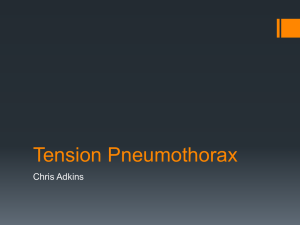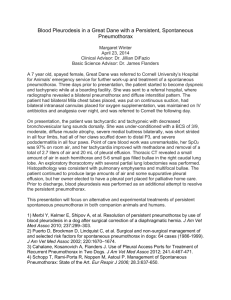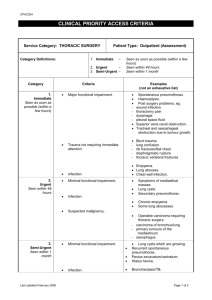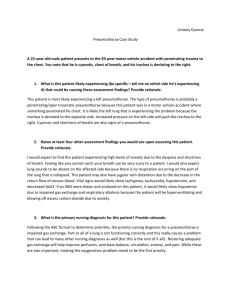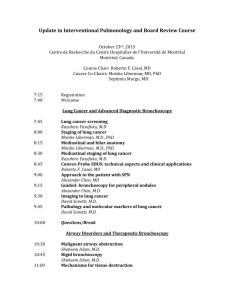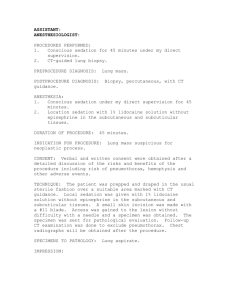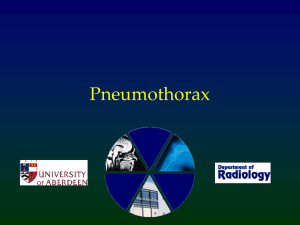Hydrothorax
advertisement
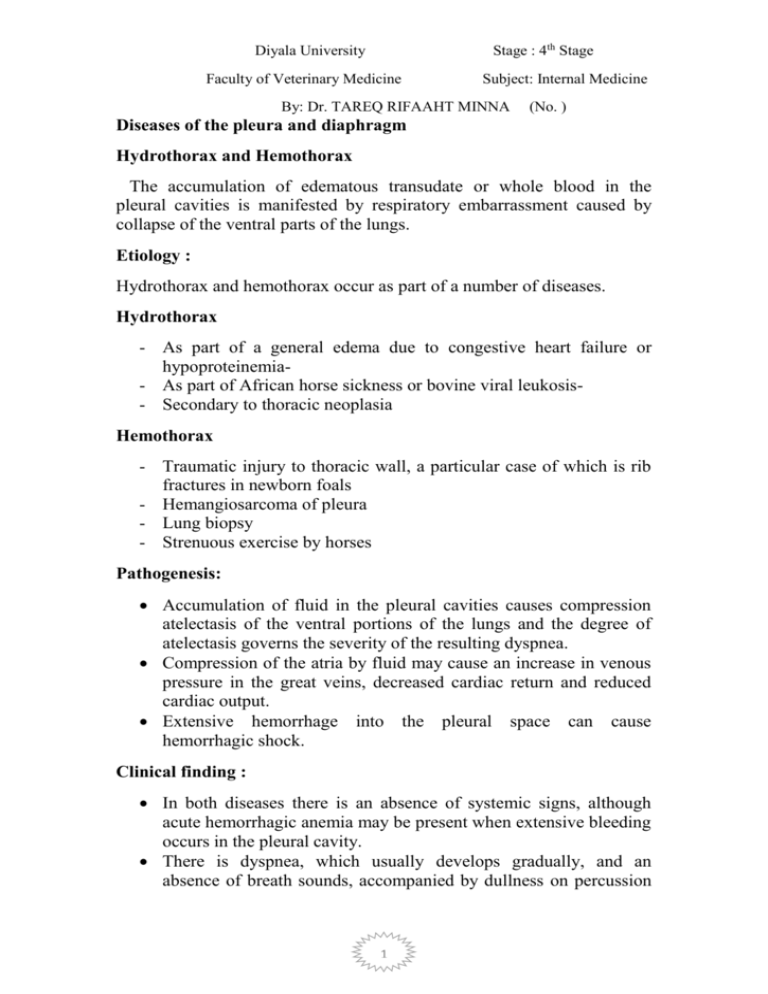
Stage : 4th Stage Diyala University Faculty of Veterinary Medicine Subject: Internal Medicine By: Dr. TAREQ RIFAAHT MINNA (No. ) Diseases of the pleura and diaphragm Hydrothorax and Hemothorax The accumulation of edematous transudate or whole blood in the pleural cavities is manifested by respiratory embarrassment caused by collapse of the ventral parts of the lungs. Etiology : Hydrothorax and hemothorax occur as part of a number of diseases. Hydrothorax - As part of a general edema due to congestive heart failure or hypoproteinemia- As part of African horse sickness or bovine viral leukosis- Secondary to thoracic neoplasia Hemothorax - Traumatic injury to thoracic wall, a particular case of which is rib fractures in newborn foals - Hemangiosarcoma of pleura - Lung biopsy - Strenuous exercise by horses Pathogenesis: Accumulation of fluid in the pleural cavities causes compression atelectasis of the ventral portions of the lungs and the degree of atelectasis governs the severity of the resulting dyspnea. Compression of the atria by fluid may cause an increase in venous pressure in the great veins, decreased cardiac return and reduced cardiac output. Extensive hemorrhage into the pleural space can cause hemorrhagic shock. Clinical finding : In both diseases there is an absence of systemic signs, although acute hemorrhagic anemia may be present when extensive bleeding occurs in the pleural cavity. There is dyspnea, which usually develops gradually, and an absence of breath sounds, accompanied by dullness on percussion 1 Stage : 4th Stage Diyala University Faculty of Veterinary Medicine Subject: Internal Medicine By: Dr. TAREQ RIFAAHT MINNA (No. ) over the lower parts of the chest. In thin animals the intercostals spaces may be observed to bulge. Present of sufficient fluid may cause compression of the atria and engorgement of the jugular veins and Increased of a jugular pulse amplitude . Clinical pathology: Thoracocentesis : present of clear serous fluid in hydrothorax. Blood in recent cases of hemothorax. Radiographic or ultrasonographic examination: The accumulation of pleural fluid or blood is evident on of the thorax. Large quantities of blood in the pleural cavity have a characteristic Swirling, turbulent appearance. Necropsy finding: In animals that die of acute hemorrhagic anemia resulting from hemothorax The pleural cavity is filled with blood, not clotted, the clot having been broken down by the constant respiratory movement. Hydrothorax is not usually fatal but is a common accompaniment of other diseases. Differential diagnosis : Hydrothorax and hemothorax can be d differentiated from pleurisy by the absence of pain, toxemia and fever and by the sterility of an aspirated fluid sample. Treatment: In severe dyspnea aspiration of fluid from the pleural sac causes a temporary improvement but the fluid usually reaccumulates rapidly. In severe hemothorax Parenteral coagulants and blood transfusion . 2 Stage : 4th Stage Diyala University Faculty of Veterinary Medicine Subject: Internal Medicine By: Dr. TAREQ RIFAAHT MINNA (No. ) PNEUMOTHORAX Pneumothorax refers to the presence of air (or other gas) in the pleural cavity. Entry of air into the pleural cavity in sufficient quantity causes collapse of the lung and impaired respiratory gasexchange with consequent respiratory distress. Etiology: - The common cause is rupture of the lung or secondary to thoracic trauma, - Penetrating wound that injures the lung, or lung disease. - Trauma to thoracic wall when a wound penetrates the thoracic wall, including the parietal pleura. - Thoracotomy, thoracoscopy or drainage of pleural or pericardial fluid. - Injury or surgery to the upper respiratory tract, presumably because of migration of air around the trachea into the mediastinum and subsequent leakage into the pleural space. - Perforating lung injury in newborns as rib fractured during birth and the lung lacerated by the sharp edges of the fractured rib. Type of Pneumothorax: - Spontaneous pneumothorax occur without any identifiable inciting event. - Open pneumothorax describes the situation in which gas enters the pleural space other than from a ruptured or lacerated lung, such as through an open wound in the chest wall. - Closed pneumothorax refers to gas accumulation in the pleural space in the absence of an open chest wound. - Tension pneumothorax occurs when a wound acts as a one-way valve, with air entering the pleural space during inspiration but being prevented from exiting during expiration by a valve-like action of the wound margins. 3 Stage : 4th Stage Diyala University Faculty of Veterinary Medicine Subject: Internal Medicine By: Dr. TAREQ RIFAAHT MINNA (No. ) Pathogenesis: - Entry of air into the pleural cavity collapse of the lung. partial or complete - Collapse of the lung results in alveolar hypoventilation, hypoxemia, hypercapnia, cyanosis, dyspnea, anxiety. - Tension pneumothorax lead to a direct decrease in venous return to the heart by compression and collapse of the vena cava. - The degree of lung collapse varies with the amount of air that enters the cavity;,small amounts are absorbed very quickly . but large amounts may cause fatal anoxia. Clinical signs: 1- There is an acute onset of inspiratory dyspnea, which may terminate fatally within a few minutes if the pneumothorax is bilateral and severe. 2- The rib cage on the affected side collapses and shows decreased movement when one pleural sac is collapse. 3- On auscultation of the thorax, the breath sounds are markedly decreased in intensity and commonly absent. The mediastinum may bulge toward the unaffected side and may cause moderate displacement of the heart and the apex beat, with accentuation of the heart sounds and the apex beat. 4- The heart sounds on the affected side have a metallic note and the apex beat may be absent. 5- On percussion of the thorax on the affected side, a hyperresonance is detectable over the dorsal aspects of the thorax. 6- There are usually signs of the inciting disease, including fever, toxemia, purulent nasal discharge and cough due to secondary lung disease particularly infectious lung disease. Clinical pathology: Definitive diagnosis is based on demonstration of pneumothorax by radiographic or ultrasonographic examination. 4 Stage : 4th Stage Diyala University Faculty of Veterinary Medicine Subject: Internal Medicine By: Dr. TAREQ RIFAAHT MINNA (No. ) A- Radiography permits the detection of bilateral and unilateral pneumothorax and permits identification of other air leakage syndromes including pneumomediastinum, pneumoperitoneum, and pneumopericardium. B- Ultrasonography is also useful in determining the extent of pneumothorax and the presence of consolidated lung and pleural fluid. C- No specific changes in hematological and serum biochemical Values. D- Arterial blood gas analysis reveals hypoxemia and hypercapnia. Necropsy finding The lung in the affected sac is collapsed. In cases where spontaneous rupture occurs there is discontinuity of the pleura, usually over an emphysematous bulla. Hemothorax may also be evident. Differential diagnosis : The clinical findings are usually diagnostic. Diaphragmatic hernia may cause similar clinical signs but is relatively rare in farm animals. In cattle, Diaphragmatic hernia is usually associated with traumatic reticulitis and is not usually manifested by respiratory distress. Large hernias with entry of liver, stomach, and intestines cause respiratory embarrassment, a tympanitic note on percussion and audible peristaltic sounds on auscultation. Treatment: The treatment depends on the cause of the pneumothorax and the severity of the respiratory distress and hypoxemia. - Animals with closed pneumothorax not require specific treatment should be confined and prevented from exercising until the signs of pneumothorax have resolved. - An open pneumothorax, due to a thoracic wound, should be surgically closed. - Prophylactic antimicrobial treatment is advisable to avoid the development of pleurisy. 5

